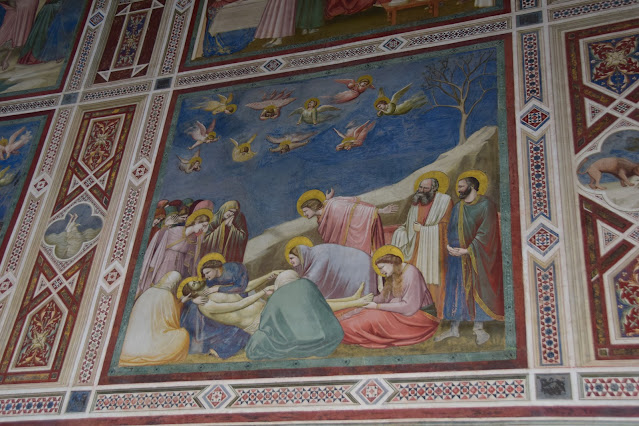We knew we wanted to go to Trieste and Florence but had to think about what other two places we wanted to visit in between. I had always wanted to see the Piero della Francesca cycle of the Legend of the True Cross in Arezzo, and in some ways the trip was organized around that. Looking for the 4th city, we decided on Padua because of the Giotto frescoes. Then in Florence we went to various churches famous for frescoes. The trip wasn't initially planned as a fresco trail, but that it is what it eventually evolved into. (I took pictures, not beause they captured what I was looking at in any particularly good way, but because photographing helped me see close-up and find a focus for that seeing; that is, I clearly recognize this is NOT "art photography.)
1. Padua and the Giotto frescoes at the Scrovegni Chapel.
Our visit to the Scrovegni was so spectacular, so powerful, so all-encompassing, and so incomplete. Incomplete because one is only allowed in the temperature controlled space for 15 minutes. (You have to make reservations ahead of time, get there a half hour before your time, sit in a special room where you are stabilized to a certain and humidity or whatever for 15 minutes.) So you and your 24 co-visitors are trying to see as much as you absolutely can.
Since I knew I wouldn't have much time, I did as much research as I could so I would know where to look. I discovered that Giotto(1267-1337) and Dante (1265-1321) were almost exact contemporaries, and some people say that in their work we can see the birth of Humanism and the early Italian Renaissance. Giotto is one of the first Italian painters to create religious figures that have both a body that is located within three-dimensional space and also have an individual face or presence. The frescos in the Scrovegni Chapel depict scenes in the life of the Virgin Mary and Christ and were painted in the early 1300s.
This panel, Weeping Over the Body of Christ, is said to be Giotto "at the height of his artistry.
2. Arezzo and the Piero della Francesca frescos of the Legend of the True Cross in the Choir of San Francesco..
I first wanted to see The Legend of the True Cross, Piero della Francesca's most famous and complex work, when I read the John Mortimer novel Summer's Lease, in which the characters travel in a single day to Arezzzo, Sansepulcro, Monterchi, Urbino to see Piero's most famous paintings in situ. This episode is recounted at the beginning of John Pope-Hennessey's small book, drawn from a lecture, entitled The Piero della Francesca Trail. Pope-Hennessey tells this story to make the point that Piero's paintings, once not well known, are today very famous. Piero della Francesca's dates (c. 1415-1492) are a little over 100 years later than Dante or Giotto, and the Legend of the True Cross was painted between c. 1448 to c. 1466--so something a little less than 150 years after the Scrovegni frescoes.
Piero della Francesca's art is marked by new possibilities of perspective in painting, and is much more rational and cool in its emotions. The narrative of the frescos is much more complex--there is a lot going on. So the cycle itself allows a more varied presentation. When we were there, it was quite crowded. (The space is smaller than the Scrovegni, and there were (or at least it felt like there were) more people inside. You had to jostle for position. Again, it's hard to know how to look at this kind of art: varied, unfamiliar, not particularly well-lit, lots of people, and a limited time to do the looking. So my memory (and my pictures) are kind of choppy.
How different it must have felt to decide to paint a picture and hang it on wall rather than paint the whole wall itself.
3. Florence and the Masolino and Masacio frescoes at the Brancacci Chapel.
The frescoes in the Brancacci Chapel on the other side (altroarno) were painted between around 1423 and 1436 by the two painters Masolino and his younger (and more talented and famous) colleague Masacio. They tell the stories of St. Peter. The difference between the two painters can be seen most directly in their separate versions of the story of Adam and Eve, Masolino telling the story of their time in the Garden: elegance.
And Masaccio depicting their expulsion: psychological terror.
We were also taken with the clever use of architectural space and the unique individualism of the characters.
Why, you may ask, did I take pictures of these objects, so hard to see and so often reproduced more faithfully by professionals? I will return to this question in a later blogpost.
#Italy
#Frescoes
#Giotto
#PierodellaFrancesca
#Masaco
#Masolino
































Colours have been beautifully restored/preserved. We have a old medieval Church near where I live where you can see the vague remnants of original frescoes and I always like to imagine that the interior looked something like your photographs but then Yorkshire was never Italy
ReplyDelete